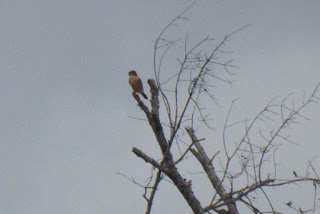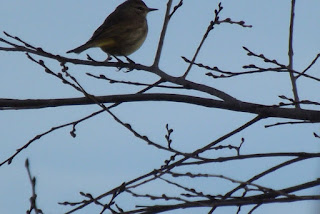 |
| American Coots (Lake Fayetteville, Arkansas, November 27, 2014) |
The 101st Christmas Bird Count, back in December 2000, was my introduction to both my local Audubon Society chapter and the wider world of birdwatching. Prior to that experience, I had birded mostly around my own yard in rural Mississippi, and certainly didn’t know anyone else who shared my avid interest in birds. But all of that changed. The count leader assigned my mother (who did the driving) and me to an area that included a portion of the local reservoir and dam, as well as the neighborhoods adjacent to it. I remember standing at our first stop on the route, shivering in my heavy coat and thick gloves as I observed Bufflehead ducks and American Coots bobbing in the waves near the spillway. Fortunately, the temperature increased considerably as the day progressed, as did the numbers on my bird checklist and my appreciation for this challenging but enjoyable form of citizen science. What had originally been only a hobby for me was now a way to make a real contribution to ornithology.
The Christmas Bird Count is one of the longest-running wildlife censuses. The period of December 14, 2017 through January 5, 2018 marks the 118th time that the count has been conducted. Like many birdwatchers, I’ve already participated in my local CBC this year. Some hardworking people will even be involved with more than one count. The count circles, of which there are several per state or province, measure 15 miles in diameter, and each count compiler assigns portions of the count area to the various groups or individuals to cover. The rules for counting are fairly simple: all observed, identified wild birds should be included in the tally, and the same area cannot be surveyed more than once.
 |
| American Kestrel seen on Noxubee NWR CBC, December 17, 2016 |
In addition to being a fun time in the field, the Christmas Bird Count is a great way to touch base with other birders and hone one’s birding skills. While I normally do make an effort to keep accurate tallies of birds that I observe, the CBC forces me to pay even closer attention to what I’m seeing and hearing—to locate and identify every individual bird that I possibly can. A lot of CBC work involves intensely focusing on details: listening carefully to detect all of the brief contact and alarm calls from sparrows, kinglets, warblers, chickadees, titmice, wrens, nuthatches, and creepers in the dense woods; scanning distant rafts of waterfowl for subtle differences in plumage between species; trying to get a reasonable estimate of the number of individuals in an enormous flock of blackbirds, robins, or waxwings; and so forth.
 |
| One of the most common songbirds seen in the winter months in North America: the White-throated Sparrow. (Fayetteville, Arkansas) |
The Christmas Bird Count began in 1900 as a response to the then-common “side hunts” that involved teams of hunters competing to see who could shoot the most animals—birds included—on Christmas Day. The count’s founder, Frank M. Chapman, was a prominent ornithologist and conservationist who (quite understandably) found the tradition of “side hunts” to be irresponsible and repulsive, so he recruited a number of colleagues from all around the country to count all of the birds that they could find on Christmas. Although the CBC has expanded considerably since its conception, its basic formula hasn’t changed much. The fairly simple, straightforward rules make it just as fun for beginners as it is for those who have done it for years.
Considering how simple the CBC really is, how valuable could its results be to ornithology? In some cases, more valuable than one might think. For example, Niven et al. (2004) used CBC data to examine population changes in the bird species that breed in the boreal forests of Canada and Alaska and winter farther south. Some of these boreal species, such as Merlins and Palm Warblers, showed population increases. Populations of several other species were relatively stable, while some species, including Harris’s Sparrows, Rusty Blackbirds, and Northern Shrikes, had declined significantly. The researchers noticed that the CBC winter population trends paralleled those in the data from the Breeding Bird Survey, another long-running bird census.
 |
| Merlin at Choctaw Lake, MS, December 31, 2015. |
Like the authors of the boreal species study, Link et al. (2006) found that CBC data matched data from other surveys very well. In this instance, American Black Ducks showed similar population changes on both the CBC and the Midwinter Waterfowl Inventory—an indication of the general accuracy of CBC data! The data can also be useful for examining the impact of disease on bird populations; in 2003, C. Caffrey and C. C. Peterson looked at CBC results over a multi-year period for several common species in the northeastern U. S., and came to the conclusion that West Nile Virus had likely not significantly affected the populations in that region. And these studies are merely the tip of the iceberg; CBC data can be a treasure trove of information for a patient researcher. This is something worth celebrating about the CBC as the 118th count continues over the next week and as we move into a new year.
 |
| A rare (for the region) Palm Warbler seen on Noxubee NWR CBC, December 16, 2017. |
References:
Caffrey, C. and Peterson, C. C. 2003. Christmas Bird Count data suggest West Nile Virus may not be a conservation issue in the northeastern United States. American Birds 57:14-21.
Link, W. A., Sauer, J. R., and Niven, D. K. 2006. A hierarchical model for regional analysis of population change using Christmas Bird Count data, with application to the American Black Duck. The Condor 108:13-24.
National Audubon Society, Christmas Bird Count Compiler Resources. Retrieved December 30, 2017, from
http://www.audubon.org/christmas-bird-count-compiler-resources.
Niven, D. K., Sauer, J. R., Butcher, G. S., and Link, W. A. 2004. Christmas Bird Count provides insights into population change in land birds that breed in the boreal forest. American Birds 58:10-20.
Weidensaul, S. 2007.
Of a Feather. Harcourt, Inc., Orlando, Florida, USA.






No comments:
Post a Comment